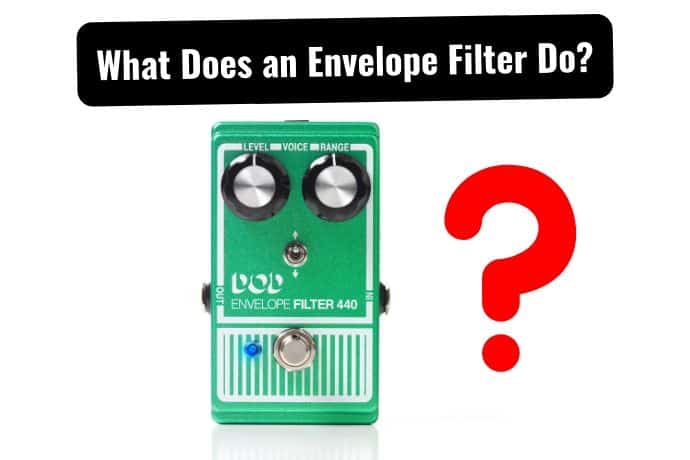
Within the vast world of guitar effects, you may have come across an envelope filter pedal?
But what is an envelope filter? And what does this pedal do to our sound when added to our pedalboard? Here’s all you need to know…
An envelope filter works by filtering out specific qualities of the audio signal either to add or remove high or low frequencies. An envelope filter also reacts to the dynamics and attack of your playing enhancing the intensity when plucking hard or decreasing it when playing softer.
In order to clear things up, we first need to sort out what “filtering” in audio processing means. Filters feature a circuit that (as their name suggests) filters out certain frequencies. These frequencies of the signal’s audible spectrum go through, while the others are filtered out.
You’ve probably also heard about low-pass filters, that allow only the bottom-end of the spectrum. We also have high-pass filtering that passes only the higher frequencies, and the so-called “band-pass” that lets the mid frequencies through.
EQ pedals are technically filters, with multiple frequency range controls on it. But the envelope filters, or just filters, are the names given to specific types of pedals.
The word “envelope” refers to different EQ curve “shapes” of the guitar or bass tone. The curve changes, starting from the moment that you play the note and until it fades out, or until you play the next note.
What’s also special about envelop filters is that they use resonance in order to emphasize desired frequencies. This way, some frequencies that passed through the filter are way more pronounced than others near them.
For guitars and bass guitars, you get that voice-like or vowel-like tone with each played note. To put it simply, it often resembles the tone of those old school synths.
You can often hear them in funk music, or any music that features funky elements in it. There are no strict rules for genres where you can implement envelope filters, and you’re always free to experiment.
How Do Envelope Filter Pedals Work?
Like we said, envelope filter pedals do their magic by filtering specific frequencies in your tone and letting through specific desired part of the spectrum. It is done “dynamically” since the EQ curve changes over time after the played note.
The most famous example of a filter pedal is a wah-wah. Whether an automatic or a controlled version, wah pedals have a sweepable peak frequency that’s filtered out. As you rock the pedal, the frequency changes, the whole EQ curve shifts, and you get this impression of a voice-like tone.
Going back to envelope filters, there’s usually a sensitivity knob that determines how the pedal will interact with the initial part of your signal. However, the sensitivity relies on the strength of the signal that’s fed into the pedal.
This means that the overall effect will depend on what you do with your volume pot on the guitar or any pedal that comes before it in the signal chain.
This also means that any envelope filter pedal is sensitive to your playing dynamics. With most of the other effects, you set the desired parameters, and they alter the tone statically, like phasers, choruses, or flangers.
With a filter pedal, the speed and the depth of the effect depend on the dynamics. When you play it forte, the effect is deeper, faster, and more intense. And if you’re gentle with your strings, the output is smoother and less pronounced.
Filter pedals have an option to make the “opening” or “closing” sounds. Opening sounds start with a narrow frequency scope and then widen it, whereas the closing settings do the opposite – they start with a wider spectrum and then narrow it down.
Auto Wah vs Envelope Filter?
While wahs and automatic wahs are filters, there are a few things that differentiate them from pedals labeled as “envelope filters.” First, both wah and auto wah have sweepable peak frequencies, while classic filters do the aforementioned “opening” and “closing” sounds.
Now, some guitar players often put auto wahs and envelope filters in the same category. While the implementation can be similar, there some differences.
The first one, that we described, is the way they work with the audible spectrum. While both auto wahs and envelope filters are automatic effects, they don’t change the curve in the same manner.
On the other hand, some automatic wahs can work as temporal effects, changing the peak frequency according to the set speed. Imagine that you’re rocking a wah pedal precisely at a set tempo, regardless of your playing dynamics.
Are They Both the Same Thing?
Technically, both auto wahs and envelope filters can fall into the same category, as both are the effects that filter out certain frequencies. It’s just the way they affect the EQ curve, and, in some cases, we have automatic wahs that change the tone periodically instead of dynamically.
There should probably be more strict nomenclature that would separate automatic from dynamic wahs, but that’s a whole different discussion.
With this said, there’s also the question of implementations of these two effects. Automatic wahs can essentially replace regular wah pedals. This goes both for rhythm and lead sections, as well as distorted or clean tones.
However, if we’re talking about distorted rhythm sections, it wouldn’t be very practical to implement an automatic wah nor a filter for power chords or any chords, unless you have a very specific thing in mind.
It’s not that the practice is forbidden, but the resulting tone might just feel a bit too mushy for conventional use.
We would argue that envelope filters are generally a better option for certain lead sections, synth-ish bass lines, and specific riffs where notes are played one at a time.
Some of the popular automatic wahs include Boss AW-3, Mad Professor Mad-Swaw, Mooer Funky Monkey, and Electro-Harmonix Micro Q-Tron. Speaking of envelope filters, we would mention Pigtronix EP2 Envelope Phaser, Sorce Audio C4, Keeley Neutrino V2, and the well-known Line 6 FM4.
Where to place an envelope filter in the signal chain
The pedal placement has been one of the most often discussions since the invention of guitar pedals. While there are no strict rules, it is recommended to place envelope filters near the beginning of the signal chain.
If you put them after the distortion, the tone might get too chaotic. Any kind of filters usually go at the beginning of the chain, right after tuner pedals.
Depending on the effect that you want to achieve, EQ pedals can go before or after, but this is something that you’ll have to experiment with and find the most suitable placement for your needs. You should just always bear in mind that envelope filters are directly impacted by the kind of tone you feed into them.
Another question is whether you should put them before or after compressors. Since compressors alter your dynamics, you’ll lose a great portion of dynamic control over your envelope filter.
At the same time, placing filters after compression may make your overall output less dynamically compressed. The general idea is to have it before compressors.
Although it’s rare, some may prefer to use both filters and wahs turned on at the same time. This is also something that you can experiment with as different placement gives different results.
Related Questions
What does a bass envelope filter do?
A bass envelope filter works similarly as a regular guitar envelope filter by processing the signal adding or removing frequencies for a vocal esque tone. A bass envelope filter is designed to enhance the low frequencies of a bass guitar whereas regular guitar pedals enhance the mids of a regular guitar.
